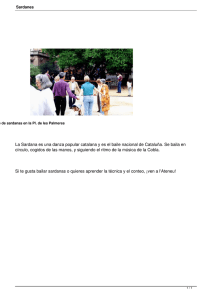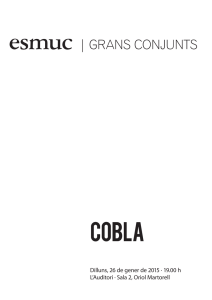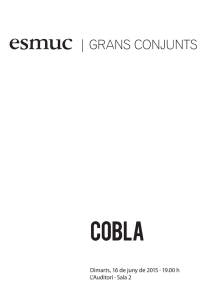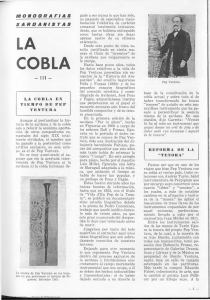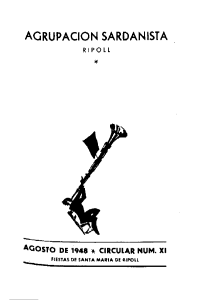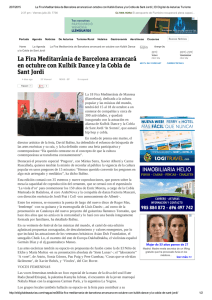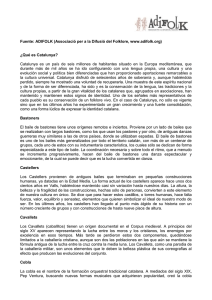Untitled - Institut Guillem de Berguedà
Anuncio
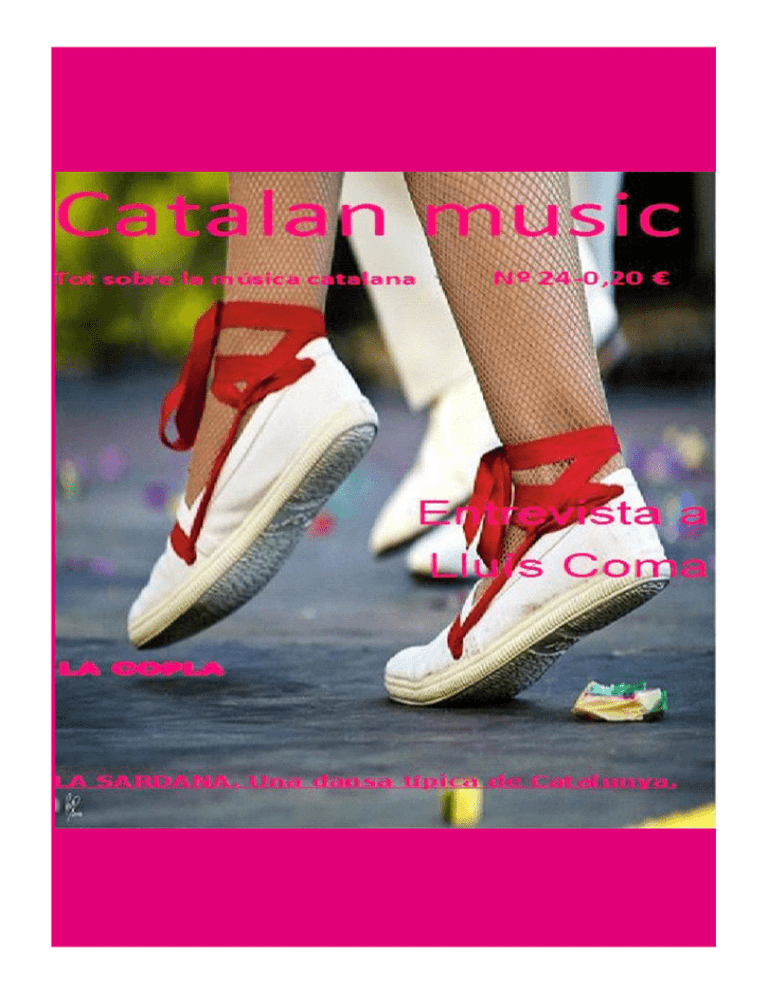
Profesors: - Queralt Santandreu - Victor Esgueva - Pere Camprubí Alumnes suecs: - Ellinor Kjellén - Hjalmar Grahn - Emilia E-Jansson - Sofia Hasselquist Alumnes catalans: - Laura Figols - Laura Tomasa - Eva Marceló - Èlia Macià ÍNDEX/CONTENTS Editorial......................................................................................................................................... 1 Our Song/Nuestra canción.............................................................................................................3 Los instrumentos de la cobla/Instruments of la cobla................................................................... 4 Articulo donde se comparan las realidades suecas y las catalanas/ Article that compares the swidish and catalan realities............................................................................................................................. 6 La sardana.................................................................................................................................... 7 Articulo critico ( La Trinca )/Critic article (La Trinca)..................................................................... 8 Entrevista a Lluís Coma/Interview to Lluís Coma..........................................................................9 Cartas al director/Letters to the director....................................................................................... 11 . Gobalización Musical/Music Globalization....................................................................................1 3 La Cobla....................................................................................................................................... 1 5 Entrevista de los alumnos suecos/Interview of Swedish students................................................1 7 Agenda cultural/Cultural activities.................................................................................................1 9 Midsuumer.................................................................................................................................... 21 Enquesta/ Surney......................................................................................................................... 23 Puzzles........................................................................................................................................ 25 E D I TO RI AL In Catalonia there are a lot of different popular music. But in particular there are one that in my opinion is the most famous around the world, this is la “Sardana“. I think that is important to speak about sardana because is a very important tradition in Catalonia. Few years ago the sardana was the absolute protagonist in all the great festivities in all the towns and cities in catalonia, but now we are losing this tradition and other music substitute la sardana. I think that it’s a pity because we are losing our traditions. We must do something for the young people learnt to appreciate the music and the dance of the sardana, because it’s a important part of our culture. The majority of cities in Catalonia have a sardana dedicate to them. In our cace, in Berga there are few sardanes that link the our town traditions and our music. For example “Corpus a Berga “ it’s a very beautiful sardana made with the Patum’s music. I think that the government will do something to promotion sardana and maintain one tradition so antique as la sardana. 1 2 AMAZING! Uoh uoh! There you go again, You will know new people. Yeah you! the Comenius... got everybody star struck We must, enjoy it the experience Because it’s a big opportunity to learn a lot of E-English! We fly over Europe, cause we hope need more freedom, If you want, we will be friends, dancing and singing. We will travel to Västervik, we will travel to Berga. cause we want see your face another more t-i-ime. Yeeah. Yeah Yeah! We are working a lot, Everything will go out well. Oh sure! Wanna see me, and soo-oon it was coming. We must, enjoy it the experience Because it’s a big opportunity to learn a lot of Spa-anish! We fly over Europe, cause we hope need more freedom. If you want, we will be friends, dancing and singing. We will travel to Vastervik, we will travel to Berga. cause we want see your face another more t-i-ime. Wish I could tell you “It will be etern” All this time hasn’t been one dream. It’s a real thing that it haves end. I miss you. Maybe, distance it’s a problem but I promise that we see-again. I think it has been amazing We fly over Europe, cause we hope need more freedom. If you want, we will be friends, dancing and singing. We will travel to Västervik, we will travel to Berga. cause we want see your face another more t-i-ime. ( BIS) Lyrics: Èlia Macià and Laura Fígols 3 THE INSTRUMENTS OF THE COBLA that is even longer. In “La Cobla” there is only one. Powered by a switch that changes the length of the tube and allows for all notes. You must be very precise position of the rod to tune the note CONTRABAIX correctly. The” Contrabaix” is a stringed instrument. Have a sound more serious than the trumpets, In “La Cobla” there is only one which is what plays a bright heroic character with a dark low register.His crucial role, is the rhythmic basis. tone is in the gift. It is a pear-shaped instrument that can be called Early trombones were built year 1 825. "Berra" and has three strings. In the early twentieth century it was common to see It is a great tool and a deep and resonant sound very verses without trombone but it went forward to serious. incorporating all, was the last instrument to join. The role of the trombone in “La Cobla” is almost always done accompaniments, reinforcing the grave acts of trumpets or the acute of flugelhorn. TIBLE It is a wind instrument, the “Cobla” there are two of these. It has characteristics similar to those of “tenora” but is shorter, measuring 55 cm. The “tible” has a shrill and piercing sound can be considered the second protagonist in the “Cobla” This instrument was created in 1 850 specifically for the ”Cobla” . La Tenora The tenora is aerofono double reed instrument from he family xeremies. Its name come from the fact xeremia tenor. It is one of the most characteristic of the couplet. The tenora consists of thirteen metal keys copied the oboe because the musicians playing different notes. Consists of five pieces, the cane, the tudell the top of the cylinder body, lower body and hood. It is basically made of wood Jujube red date tree is less than the bell metal. The current size is about 85 cm and vibrates through the action of a double reed cane. TROMBÓ It is a brass instrument mouthpiece of dosing, and body incurvat conic section in the cylindrical portion of the pavilion and the rest, much like the trumpet 4 TAMBORÍ FLUGELHORN The flugelhorn is an instrument that belongs to the family of saxhorns. This family of brass instruments is different from the trumpets and trombones that his pipe is conical rather than cylindrical, which gives a very different sonic texture. The family has a large number of instruments ranging from acute and more like the trumpet and the largest espectacular. Adolph Sax invented in the nineteenth century. In the couplet the flugelhorn with one hand harmonic and rhythmic role, and there are also other passages solo passages usually entrusted transition and its role is crucial when giving personality to the sound of the training . FLABIOL The flabiol is a musical wood and wind, the family of the flutes. Excels with its short and tailored to handle with one hand, the left. Measures approximately 20 to 25 centímetros long and has five or six and three holes reaches beneath. In the salsa was accompanied by a flute Tamborí stand with the codon that is left and right side with the Coup. All sardanas start with an introduction played by a flute. The “tamborí” is the only percussion instrument of “La Cobla”. It is a small drum (about 1 2 cm in diameter) is made of wood and leather is your diaphragm. In “La Cobla”there is only one. The “tamborí” is an instrument with little volume of sound. The tone of this instrument makes the acomapnyament in “Sardanes” along with the bass. It is played by the same person as the “flabiol”. Usually the musician who played the leads attached to the left and right utilitzan played with a wooden bench, with the left hand plays the “flabiol”. TRUMPET The trumpet is a musical instrument belonging to the family of brass instrument or metals, fabricated metal alloy. The history of the trumpet goes back to the origins of human history.Almost as old as the flute, which is reputed as the most ancient and widespread, they should be the trumpet and cornet, derived from ox horn can still serve as a hunting horn. 5 COMPARING THE SWEDISH REALITIES WITH THE CATALANS them grow up. In Sweden the vegetables growing is much more difficult. These are the main differences and similarities between Sweden and Catalonia. Sweden, being a northern country , has lower temperatures tan Catalonia, but it has many other similarities that we are going to see for example the Swedish economy is directed to the export, the same that the Catalan economy. They also have big very developed nets of communication. But they have something very different. It is the currency. They don use the Euro. They use the SWEDISH KRONA /sek/. 1 e is about 9,6 SEK. They sleak Swedish. They even have English like a second language, like we have Spanish. We also speak English. There are different religions in Sweden, but most of the people belongs to the Swedish Church, /72,9%/ in 2008. Some 275,000 Swedes are today members of various free churches and immigration has meant that there are now some 92,000 Roman Catholics and 1 00,000 Eastern Orthodox Christians living in Sweden. Because of immigration, Sweden also has a significant Muslim population. Almost half a million are Muslims by tradition, but approximately 5% (25,000) of these actively practice Islam (in the sense of attending Friday prayer and praying five times a day. In Sweden there are different types of music, like the SAMI music, from the SAMI people, and known as joik. The Swedish folk music has got traditional interpretations that it incorporates elements fromthe jazz and rock. Chorus is a very popular activity specially in their churches, where people sing choral music. But in Catalonia, the traditional music is the Cobla. They play the music en the traditional dances and choirs. Of course, both Sweden and Catalonia take music from other countries. About food, we are very nearly the same. Its food is, mainly, based in meat and fish, mixed with sauces , but we eat much more vegetables because of the temperature in our country that let 6 LA SARDANA HISTÓRIA La sardana es una danza popular catalana y es el baile nacional de Catalunya. Se baila en circulo siguiendo la música interpretada por una cobla. Los participantes se cogen de las manos por parejas, entendiendo como pareja un hombre que coge con la mano derecha a una mujer, que resulta por lo tanto en un patrón alterno de hombre-mujerhombre-mujer. La sardana tiene su origen en la isla de Cerdeña donde se baila un baile típico hace siglos que se llama "Su passu torrau" entre otras modalidades. De allí se la trajeron los catalanes en sus viajes junto a Alfonso el Magnánimo en pleno renacimiento.[. Su popularidad y extensión crecieron considerablemente en las últimas décadas del siglo XIX. Pep Ventura se estrenó como a musico coblaire (1 837). A él es debido el acertado ajustamiento de instrumentos que, con ligeras alteraciones, se ha consagrado: flabiol i tamborín, dos tibles, dos tenoras, dos trompetas, un trombón, dos fiscornos y un contrabajo. Reformó y adoptó el conjunto de cuatrocientas cardanes, escritas en mano, se conserva a la biblioteca de l’Orfeó Català. Miquel Pardàs que publicó el 1 850 a Figueres el primer Mètode per a aprendre a ballar sardanes llargues. El nombre de coblas aumentó. La peculiaridad musical i la curiosidad coreográfica daban a la sardana un sello de catalanismo. Salvo esporádicos bailes en el verano del 1 859, las coblas no acudieron a Barcelona hasta doce años más tarde, con motivo de las fiestas de la Mercè. La sardana es tocada actualmente por una cobla que consta de 1 2 instrumentos tocados por 11 músicos. Cuatro de estos instrumentos (tenora, tible, flabiol y tamboril) son instrumentos típicamente catalanes o versiones diferenciadas sólo usadas en Cataluña. Los otros (trompeta, trombón, fiscorno y contrabajo) son más convencionales. ESTRUCTURA La sardana se compone de una determinada sucesión de compases, cada compás es un punto o paso que se tiene que hacer. La componen dos partes, una que se llama curts, variable de dieciocho a cuarenta compases, y la otra se llama llargs, de cincuenta y cinco a ochenta y cinco compases. Las dos partes juntas son llamadas tirada y el orden en que se hacen figura en organigrama. Por lo que se refiere a la longitud de una sardana, hay sardanas de 7 y de 1 0 "tirades", que tienen unas estructuras definidas de pasos "curts" (cortos) y "llargs" (largos). Al principio de la sardana siempre hay un preludio de un flabiol; el mismo instrumento hace el contrapunt al inicio de la quinta i de la sexta tirada de llargs; Estas sonadas son para que la gente preste atención y no se bailan. La tirada de cortos tiene un nombre impar de compases, de dieciséis a cuarenticinco, y se caracteriza porque en estas tirades los bailarines mantienen los brazos abajo. En el primer compás de la tirada el pie izquierdo avanza, hace un punto en el suelo y retrocede. En el siguiente compás se desplaza hacia la derecha y seguidamente marca un nuevo punto con la derecha. Lo sigue un nuevo desplazamiento y un punto hacia la izquierda y así sucesivamente alternándolos. Cada cuatro compases se vuelve al mismo lugar. Habitualmente la tirada de llargs tiene un nombre impar de compases, de cincuenticinco a noventicinco, en este caso los bailarines levantan los brazos. Los desplazamientos a derecha i a izquierda son idénticos a la tirada de curts, con la diferencia que en la tirada de llargs el nombre de puntos a marcar es tres, en vez de uno. Cada ocho compases vuelve al mismo lugar. 7 COMO ERA LA TRINCA Y COMO ES AHORA DESDE EL PUNTO DE VISTA DE LOS JOVENES La trinca es uno de los primeros grupos musicales que se crearon en Cataluña en la década de los 70. Estaba compuesto por 3 cantantes, Josep Maria Mainat, Miquel Àngel Pasqual y Toni Cruz. En esa época había la dictadura de Franco, en esos tiempos la libertad de expresión era muy limitada y aun mas si era en catalán. Creo que este grupo tenia la genialidad de crear canciones de doble sentido, un lado parecían canciones de berbena i de fiesta por sus melodías divertidas,i por sus temáticas cercanas a su generación como la canción de “sexe,droga i rockandroll” y por otro, canciones vinculadas con la representación. A través de su letra nos damos cuenta de la gran critica contra el régimen franquista que prohibía hablar abiertamente de muchas cosas, sobretodo de las relacionadas con la política y la libertad. Las letras de las canciones de la Trinca eran importantes porque reivindicaban la sociedad liberal de una manera divertida y cercana que llegaba a todo tipo de público. Por ejemplo una de sus muchas canciones es la de “Prim,prim,prim i mort de gana” que creo fue una canción escrita para la baja sociedad Catalana que vivía un tiempo de pobreza pero con un ritmo y una letra divertida para sobrellevarlo. En esa época era impensable y estaban mal vistas muchas cosas de las que ahora son normales y ya a nadie sorprenden. Las letras de la trinca aun hoy son utilizadas en diferentes situaciones políticas o sociales. Ahora sus personajes se han hecho mayores, y han realizado un programa para elegir a una nueva generación de la Trinca. Ahora podemos revivirla de forma un poco diferente, pero igual en sus momentos alocados y divertidos. Han salido elegidos para representar a este nuevo grupo: Marc, Dídac y David que harán una recopilación de los momentos más representativos y los recibirán en una película. 8 ENTREVISTA A LLUÍS COMA Somos un grupo de cuatro alumnos del instituto Guillem de Berguedà que estamos realizando un trabajo de música dentro del marco de un Proyecto Comènius. Este proyecto lo estamos haciendo conjuntamente con los alumnos de un instituto de Suècia. El tema de nuestro trabajo es la música popular catalana. Por este motivo hemos creído que era muy importante explicar una de las formaciones típicas de Ctalunya, "la cobla". Hemos establecido contacto con el Sr. Lluís Coma que es un músico que hace más de ...... años que forma parte de las coblas más importantes de nuestro país. Él nos ha respondido la siguiente entrevista que nos proporciona muchíssima información acerca de lo que significa tocar en una cobla. -Señor Coma, en primer lugar, ¿de dónde es usted? Abans de començar, disculpeu-me per contestar les preguntes en català, ja que em será més fácil expressar-me. Si us convé pel vostre treball podeu traduïr les respostes. Em dic Lluis Coma i Coll, tinc 62 anys i vaig néixer a l’Hospitalet de Llobregat on havien anat a viure els meus pares quan es van casar; ells provenen de pobles de la Catalunya central: Sant Feliu Sasserra el pare i Santa Maria d’Oló la mare. -¿Qué instrumento toca y en que cobla? El flabiol i el tamborí; són dos instruments que els toca un sol instrumentista, el flabiol amb la mà esquerra i el tamborí amb la mà dreta. La Cobla actual és La Principal de Terrassa. -¿Cuándo aprendió a tocar este instrumento? Quan tenia divuit anys em vaig comprar el primer flabiol marca Romero, de Gavà, per acompanyar els balls de bastons de la colla del poble, i vaig aprendre a tocar de manera autodidacta fins un nivel bàsic. Als trenta-un anys em vaig engrescar a tocar sardanes i aleshores durant dos anys vaig fer els estudis de flabiol i tamborí de manera sistemática seguint el mètode del mestre Narcís Paulís i els exercicis de mecanisme del mestre Jordi Leon. I em vaig comprar el segon flabiol construit per en Reig, de Torelló. -¿Dónde aprendió usted a tocar? El meu mestre va ser el flabiolaire de Sabadell en Santiago Olzina, que em rebia a casa seva els dissabtes al matí per passar els exercicis que jo havia estudiat a casa cada dia de la setmana. Abans no hi havia cap Conservatori on s’estudiessin els instruments de cobla (especialment flabiol, tenora i tible) i t’havies de buscar un mestre que te’n ensenyés a casa seva. -¿Cuánto tiempo hace que toca en la Cobla? Com us he dit abans els estudis d’instrument els vaig començar força gran, de manera que no vaig debutar a la Cobla fins els trenta-tres anys; ara fa, doncs, vint-i-vuit anys que toco sardanes. -¿Podría explicar-nos la estructura que tiene (músicos, instrumentosa)? La formació de Cobla més freqüent es d’onze músics colocats en dues files: cinc a la fila del davant que toquen asseguts (un flabiol i tamborí, dos tibles i dues tenores) i sis a la fila del darrere que toquen drets (duess trompetes, un trombó, dos fiscorns i un contrabaix). -¿Cuántas Coblas similares a la suya cree usted que hay en Cataluña? Tinc entès que arriben a unes 11 0 entre el Principat i la Catalunya Nord. -¿Qué tipo de música interpreta la Cobla? El repertori tradicional es composa de quatre grans grups que practiquen la majoria de Cobles: . Sardanes (ballades, aplecs i concursos) . Acompanyaments de Festa Major (cercaviles, Misses i concerts) . Ballets (les dances dels Esbarts) . Balls vuitcentistes (balls de saló instrumentats per a Cobla) En els últims anys algunes Cobles de primera categoria s’han endinsat també en el camp simfònic (poemes simfònics, cantates i obres de càmera) amb molts bons resultats, però de moment es una activitat minoritària. -¿En qué lugares actúan? La sonoritat de la Cobla està pensada per actuar 9 a l’aire lliure, es a dir, a qualsevol plaça de qualsevol poble on hi hagi un mínim espai per ballar sardanes, o bé a les places Majors per a Concursos de Colles Sardanistes i per aplecs de vàries Cobles, o també a allunyats llocs boscans on es cel.lebren aplecs d’Ermites. Normalment només és en cas de mal temps que aquestes activitats es desplacen a llocs tancats (sales d’actes i pabellons poliesportius) on la sonoritat de la Cobla perd molta qualitat. En quan a l’àmbit geogràfic, algunes Cobles recorren tot el país i també fan esporàdiques sortides a Espanya i a l’extranger, però la majoria tenen un àmbit només comarcal o provincial. Cobla mai les he près com un treball sinò com un esbarjo; es guanyen diners però no per viure’n. Només deuen ser els músics de 7 ó 8 Cobles molt professionalitzades en tot Catalunya que poden viure exclusivament de la música de Cobla. -Y para finalizar, ¿tiene previsto tocar muchos años más en la Cobla? Doncs no gaire més perquè ultimament m’estic embolicant en altres activitats musicals al meu poble, i cada vegada tinc menys temps. I també perquè ja tinc una edad que aconsella deixar pas a altres músics joves amb molta empenta i qualitat. -Usted, ¿en qué sitios ha actuado? Us diria que a les places Majors de quasi la meitat de pobles de Catalunya; seria interminable anomenar-los. -¿Cuál recuerda en especial? Per suposat la primera actuació, que va ser a Alella, on no sé si era més gran la por o la il.lusió. I una llarga llista de llocs emblemàtics com a dalt a Montserrat, la Plaça Sant Jaume de Barcelona, el Parc Güell, etca -¿A qué edad empezó usted a tocar? L’activitat musical la vaig començar de molt jove en camps diferents, però com a músic de Cobla soc una mica tardà, doncs vaig començar als 33 anys. -¿En cuántas Coblas distintas ha tocado? He fet bolos (actuacions esporàdiques) amb 1 0 ó 1 2 Cobles, però com a músic de plantilla només he estat a tres Cobles: Cobla Verneda (ja desapareguda), Cobla La Principal de Collblanc (que actualmente es diu Cobla Baix Llobregat), i Cobla La Principal de Terrassa. -¿Puede un músico como usted vivir de la música? Ni molt menys; jo, com la majoria de músics de Cobla, sempre he tingut una altra feina professional durant la setmana per obtenir la part important dels meus ingressos, i les actuacions del dissabte i diumenge amb la 10 CARTA AL DIRECTOR LETTER TO THE DIRECTOR Señor director, quería hacer un comentario sobre la programación de actos festivos, que este Corpus hemos tenido en Berga. Como es sabido cada año al finalizar la Patum del jueves y del domingo por la noche, en la plaza Viladomat “el Vall” se bailan sardanas y muy especialmente se acaba la audición con la sardana típica de la Patum “Corpus a Berga”. Este año por falta de presupuesto municipal se han suprimido estas audiciones nocturnas. Como ciudadana de Berga expreso mi firme rechazo ante este hecho, ya que considero que el Ayuntamiento Municipal destina dinero a otros actos que no son tan significativos para los ciudadanos de Berga, como una de sus tradiciones más preciadas. Quiero proponer que si el próximo Corpus tiene que pasar lo mismo, tendremos que ser los ciudadanos los que nos movamos para poder financiar esta audición de sardanas que, es muy importante para los “berguedans”. Mr Editor. I want to tell you about “the Sardanes” at the last weekend I think they were in a not very suitable place,because it was really terrible and “the Cobla” made many mistakes while they were playing. I would appreciate that these mistakes don’t happen any more. Att: Eva Marceló Firmado : Laura Figols Isach 11 LETTER TO THE DIRECTOR CARTA AL DIRECTOR Dear Sir, Last Sunday while I was walking in the center of Barcelona, near the cathedral, I listened to some music in the street. I went in front of the cathedral and I saw a group of ten musicians. Five of them were sitting and five were standing behind them. They were playing a typical song of Catalonia, “La Sardana”. There were a lot of people dancing in front of them. They were dancing in a round with their hands joined. It was very beautiful and all the people enjoyed dancing this song. But my surprise was that there were only old people dancing. I didn’t see young people there. Why? What is happening with the tradition? Aren’t these traditions enough interesting for the teenagers? Where were the young people this beautiful Sunday of April? We must do anything. School has something to do about this. I think that it’s important for a country that people don’t forget the traditions. I hope that someone will do something, because if we don’t do something, this traditional dance will disappear. Hola, hace días que voy a ver a las coblas y a las agrupaciones sardanistas, y últimamente no hay gente joven, ni adolescentes. A los chicos jóvenes ya no les interesa ni las sardanas ni tocar para coplas, y eso es malo, ya que la sardana es la danza típica de Cataluña y sino la fomentamos, se va a acabar perdiendo. Desde el ayuntamiento tendrían que hacer cursos, para informar a la gente y enseñarles lo bonito que es este baile, y lo importante que es conservarlo. Así los jóvenes pondrían más interés. Laura Tomasa Èlia Macià Puig 12 MUSIC GLOBALITZATION Many years ago, when the communications around the world were very difficult, the music and the dance were very specific in every country. All the communities have different musical traditions and dances. For example, people in Catalonia listened to and danced Sardana’s music, ball de bastons,a and in Sweden /the polka/. But nowadays, people have similar likings in many aspects of their lives, because it’s easier to access to the media like Internet, television, radio, a and music isn’t an exception. When the Swedish teenagers go to the disco, they dance the same music than Catalan teens. We have to think that Sweden is the third country in the world that exports pop music, after the USA and Great Britain. The Swedish people like the same musical groups than Catalan people. For example> Lady Gaga, Britney Spears, Elvis Presley, Riana, a. It’s important to note that the role of music is, in today’s world, a key tool in the process of globalization. However this does not necessarily provide us with any reasons that would make us believe that music has a homogenizing effect on the world . Every culture will continue having its own traditions although the general globalization. 13 14 QUE ÉS LA COBLA La cobla és una agrupació instrumental d’onze persones que acompanya les sardanes. Toquen bàsicament instruments de vent (flabiol, tible, tenora, trompeta, trombó i fiscorn) de percusió (tamborí) i de corda (contrabaix). COBLES DE BERGA A Berga hi ha diverses cobles, que toquen habitualment: -La Cobla Pirineu -La Cobla Principal -La Cobla Ciutat de Berga LA FORMACIÓ DE LA COBLA La cobla com a conjunt instrumental a Catalunya ja existia al segle XVI. Però no tenia cap formació específica ni evidentment els instruments actuals, que són tots originaris del segle XIX. PEP VENTURA Pep Ventura va ser un home carismàtic i ha passat a la història de la sardana per la gran tasca musical que va portar a terme i pels canvis introduïts a la cobla. Transformà i estabilitzà la cobla en les seves característiques essencials, incorporà el contrabaix i donà a la tenora el seu paper predominant. LA COLOCACIÓ DE LA COBLA Normalment la cobla és col•loca sobre un enterimat de fusta a l’aire lliure i els intèrprets ocupen un lloc determinat segons l’instrument que toquen.La distribució dels instruments en aquesta formació manté un ordre semblant al de l’orquestra simfònica. Així d’esquerra a dreta és situen des dels més greus,al primer esgraó els de fusta (flabiol,tible i tenora) i al segon els de metall (trompeta,trombó i fiscorn).Finalment el contrabaix a l’extrem deret i el tamborí a l’esquerre percudit pel flabiolaire. 15 WHAT IS THE COBLA? The Cobla is a musical group typical from Catalonia in which wind instruments predominate, which runs the popular music of different dances, especially the Sardana. The COBLA CATALANA was born to unify the Cobla provensal, stylistically and structurallywhich consisted, without a fixed pattern, of nine lines per cobla. Cobles with the same composition, except the final tornados. It became a fixed structure of eight lines. Their origins data back to a former strucuture named THREE QUARTANS and it was formed by three musicians who played four instruments> bagpipes, the tarot, the flute and the drum. This medieval musical group grew and gave rise to modern COBLA, as we know it today. PLACING THE COBLA The Cobla is usually placed on a wooden platform in the open air, and the performers occupy a special place attending the instrument they play. The instruments distribution in this group remains on a similar order than the symphony orchestra. It is located, left to right from the lowest on the first wood step /flute and tenor tible/ On the second, metal .trumpet, trombone and flugelhorn/. Finally on the left, the Bass and drum struck to the flabiolaire. COBLES IN BERGA There are some diferents cobles,that they usually perform in Berga -Cobla Pirineu -Cobla Principal -Cobla Ciutat de Berga THE FORMATION OF THE COBLA The Cobla as a instrumental group existed in Catalonia in the sixteenth century. But it had no specific structure on the current instruments, which originated in the nineteenth century. The current Cobla is usually composed of 11 musicians playing 1 2 instruments. Some of these instruments are native and typical of Catalonia and other are used in different groups such as bands, orchestras, rock, jazz, a That is, we could say that the Cobla combines instruments from different cultures to create a musical culture itself. The instruments of the Cobla that are typical of Catalonia have developed from ancient instruments that existed in medieval Catalonia during the Middle Ages. The rest, which are not typical, have been incorporated from another groups. PEP VENTURA Josep Maria Ventura Casas was born in Alcala la Real in 1 81 7. Popularly known by the name of Pep Ventura, he was a a musician and composer who reformed and consolidated long SARDANA giving it the Cobla amplitude. He was a popular figure at the same time as a performer of the Cobla, a prolific composer and skilled tenor. 16 ENTREVISTA DE LOS ALUMNOS SUECOS Linnea ¿Qué música escuchas? Escucho todo tipo de música. Otto ¿Qué música escuchas? Escucho Elvis Presley ¿Cuál es tu cancion favorita? Elvis Presley – Got a lot of living to do ¿Te gusta bailar? Un poco ¿Cuál es tu cancion favorita? Mi canción favorita ahora es Paparazzi de Lady GaGa ¿Cuál es tu artista favorita? Elvis Presley ¿Te gusta bailar? Si, me encanta ¿Miras programas de baile? A veces ¿Cuál una artista favorita? Lady GaGa ¿Como cuáles? Let’s dance ¿Miras programas de baile? Si ¿Como cuáles? Let’s Dance, So you think you can dance Josefine ¿Qué música escuchas? Escucha hip-hop y r&b ¿Cuál es tu canción favorita? Mi canción favorita ahora es Colours of the rainbow ¿Te gusta bailar? Si, un poco ¿Cuál es tu artista favorito? Akon ¿Miras programas de baile? Si, algunos ¿Como cuáles? America’s best dance crew 17 18 CULTURAL AGEND BERGA. assistance of the authorities, the administrators and other people who take part in the Patum. When the Mass is finished, in Saint Peter square, the brilliant Patum is celebrated, which is called “de lluïment” in Catalan, because people are very responsible and want to do things correctly. At 9.30 in the evening: The are four jumps of Patum, but it is the moment of the Great Feast of fire, because the most interesting are the firejumps and the Full Demons (“Plens”). Friday 4th of June -PATUM. The Patum will be celebrated from 2nd to 6th of June in Berga. This festivity has been considered “oral and immaterial heritage of the humanity” by UNESCO. Wednesday 2nd of June At 1 2.00 at noon: The drummer (“tabaler”) and two giants (“gegants”), accompanied by the sound of the popular Pyrenean instrumental group (“cobla”), meet the people on the traditional parade, while they invite them to take part. At 8.00 in the evening: The drummer, the demons (“maces”), the great mules (“guites”) and the old giants, accompanied by the Pyrenean instrumental group, leave Saint Peter square and make a lot of jumps on the streets and squares of the town, in front of the local authorities houses. They end with the fire-jumps (“tirabols”) in Saint John and in Saint Peter squares. Thursday 3rd of June At 1 0.00 in the morning: Rockets and the typical parade by the Pyrenean instrumental group start. At 11 .00 in the morning: In the Saint Eulalia church, there is the significant Mass with the At 1 0.00 in the morning: Parade of all the children groups of the Patum with the Band of de Berga School of Music. At 11 .00 in the morning: Mass will be celebrated in Saint Eulalia church with the assistance of the authorities and the administrators. People who attend will receive some carnations and sweets with pine nuts (“panallets”). At 1 2.00 at noon: We celebrate brilliant Patum for children with the Band of the Berga School of Music in Saint Peter square. Saturday 5th of June At 1 0.00 in the morning: Parade of the Pyrenean instrumental group around the town centre. At 11 .00 in the morning: We celebrate the Mass in Saint Eulalia church with the assistance of the authorities and of the administrators. At 1 2.00 at noon: In the town hall, the Mayor deliveries the titles of “Patumaire” and “Patumaire d´honor” and the prizes of the 36th posters competition. At 8,30 in the evening: There are jumps of Patum in front of the houses of the administrators with fire-jumps in Saint John and Saint Peter squares, all of them accompanied by the Pyrenean instrumental group. 19 At 1 0.30 at night: Fireworks in Peace Avenue (“Passeig de la Pau”). Sunday 6th of June At 1 0.00 in the morning: Rockets start and the typical parade accompanied by the Pyrenean instrumental group. Other events in June in Berga On 1 3th of June: There are “Les Musiquetes de la bressola” (something like lullaby in English), which are a group of musicians that sing different typical songs for children. On 1 6th of June: There is “Tale timetable”, which is a show where a man tells some typical Catalan stories. SWEDEN On 24th of June: They celebrate Midsummer. In modern Sweden, Midsummer´s Eve and Midsummer´s Day were formerly celebrated on 23rd of June and 24th of June, but since 1 953 the celebration has been moved to the Friday and Saturday between 1 9th of June and 26th of June. It is one of the most important holidays of the year in Sweden, and probably the most uniquely Swedish in the way it is celebrated. The main celebrations take place in Friday, and the traditional events include raising and dancing around a huge maypole. Before the maypole is raised, greens and flowers are collected and used to cover the entire pole. On 1 8th of June: We celebrate The European Master Handball Championship 201 0. On 1 9th of June: There is an audition of Catalan typical dances (“sardanes”) interpreted by the popular Pyrenean instrumental group. 20 FESTIVAL IN JUNE Midsummer is a holiday which is celebrated around the summer solstice. Midsummer, we celebrate by dancing around the maypole, and usually there are herring and potatoes on the dinner table. We make beautiful wreaths of flowers and leaves that we have in our hair. Almost everyone celebrate midsummer with the there relatives. We play games, eat good food and singing. We eat: o Meatballs o Sausage o Potatoes o Herring in different flavours o Eggs o Bread o Various sauces As for dessert, we always eat strawberries with milk, ice cream, sugar and cream. Down on the town, it is always a huge maypole so anyone can go there and dance around it. Food People are dancing around the maypole 21 22 ENQUESTA/ SURNEY We decided to make a surrey about “la sardana“ a traditional Catalan dance , to see if our opinion about “La sardana” is missing in our society, is true or false. We asked: “Can you dance sardanes ? “ We interviewed 240 people, divided in 6 groups according to their age. Age People can dance “sardanes” 1 5-24 24 of 40 25-34 25 of 40 35-44 30 of 40 45-54 35 of 40 55-64 38 of 40 65 and + 40 of 40 Blue - YES, they can dance sardanes (79 % of the interviewed people) Red - NO, they can’t dance sardanes (21 % of the interviewed people) We are really surprised of the high number of people that can dance sardanes. It`s superior to 45 % of the population. 23 We see that there are a progressive knowing of “the sardana” direct proportional to people age. The older people knows a lot of “sardana” and the younger people knows few about it. _______________________________________________ Do you think, that sardanes, are only for old people ? This is other survey that we have done. We interviwed 1 00 teenagers and they said : 34 people think sardanes are only for old people. 66 people think that “sardanes” are for all the ages. Some weeks ago we thought that young people thought that sardanas were only for the old people, but our survey have been demonstrated that the young generations value “la sardana” and they think that it’s important for Catalonia, but they don’t dance it because they think that it isn’t fashionable to dance “sardanes”. 24 PUZZLES SUDOKU SOUP OF LETTERS You will find 8 Catalan musical instruments that appears in a “cobla” . You will remember that the words can be in all the directions: - Tible Flabiol Tenora Tamborí Fiscorn Trompeta Trombó Contrabaix CROSSWORD Horizontal 1 . Instrumento responsable de fragmentos contundentes.Parecido a la “tenora” 2. Conjunto de instrumentos de “la sardana”. 4.Instrumento de viento-metal,muy conocido y el mas utilizado. 5. Instrumento que se toca junto al “tamborí” Vertical 1 .Instrumento mas importante de la cobla,lleva normalmente las melodias en las “sardanes” 3. Típica danza de Cataluña. 25 CROSSWORD ACROSS 22-H: typical dance in Catalonia 1 7-J: orchestra that plays in the Sardana 1 4-J:instrument of windmetal. 9-M:instrument more appraised in the Cobla 1 9-N:instrument that it is played for the same person than the flabiol 5-A: A very known Cobla in Berga 1 2-I: Traditional party celebrated in Berga for the Corpus Cristhi 3-I:Catalonian flag DOWN 20-L:instrument played together with the Tamborí 1 -U:the dancers of the Sardana sustain the arms down 1 7-I:small pause in the dance of the Sardana 2-M: creator of the “Cobla” 1 0-K:Musical group of the seventies very known in Catalonia compound for 3 humorist singers 1 6-N:Someone who goes out days before the Patum, the popular festival, to announce its arrival and plays in some moments of the party 26
